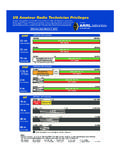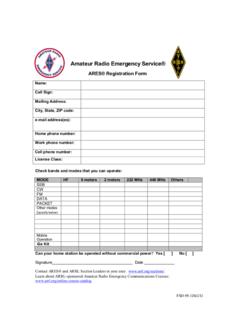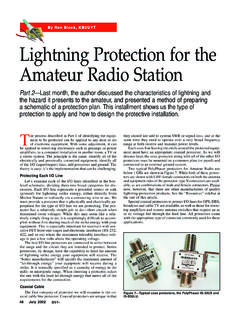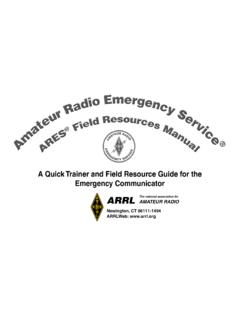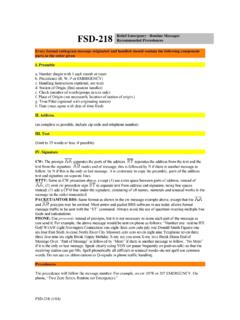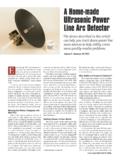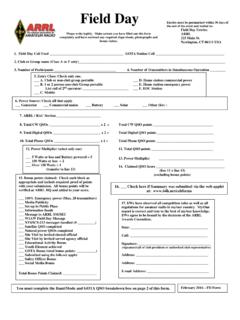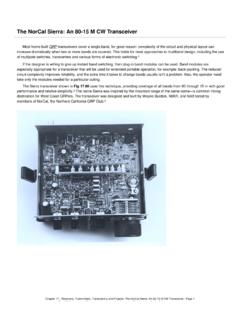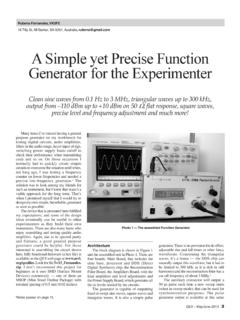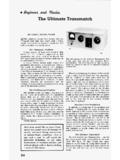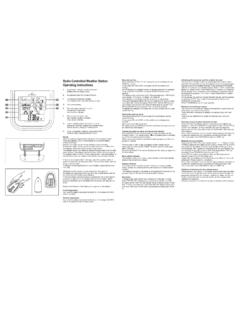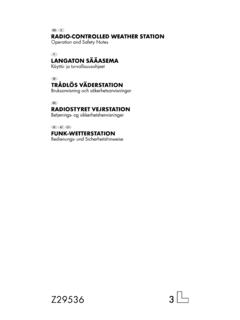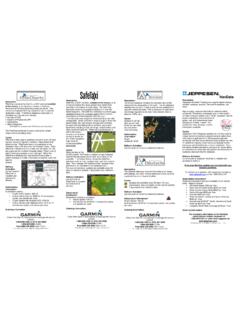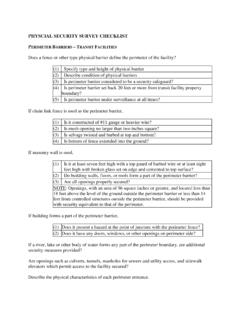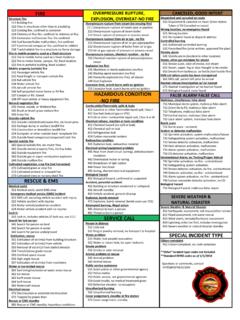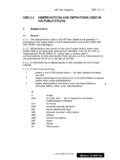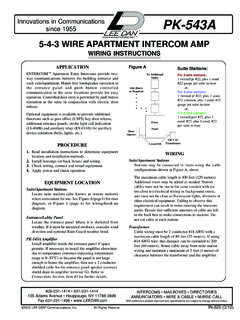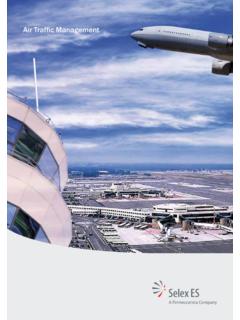Transcription of Locating RF Interference at HF - American Radio …
1 Locating RF Interference at HF. A proven and practical approach to dealing with RFI from grow lights and more. Tom Thompson, W IVJ longer ranges, however, the noise might be ing set to LINE, the RFI might be power line Radio frequency Interference (RFI) in- heard only at HF. So, HF RDF to get you related. creased dramatically in my neighborhood in VHF range can be a real time saver. See RFI from consumer devices that appears recently. Locating the sources was not for at regular intervals across the band likely easy, due in part to the distances involved. more information. comes from a switching-mode power sup- The typical range for a consumer device I also found that RFI from consumer de- ply. If the noise is pulsing it could be a bat- that meets the applicable FCC Part 15 or vices can be problematic. While FCC Part tery charger. Sharp periodic ticks could be 18 emissions limits is usually no more 15 and Part 18 rules define emissions limits from an electric fence. Variable speed mo- than a few hundred feet.
2 Some of the for most consumer electronics, the limits tors in appliances, like washing machines, sources in my area, however, were more are high enough to allow Interference to increasingly rely on electronic speed con- than a half-mile away. The usual sniff nearby Radio receivers. FCC rules protect trols and switching power supplies. See also methods weren't practical, and without an all licensed Radio services from harmful in- Light Bulbs and RFI A Closer Look for initial heading, the sources were difficult terference, and the operator of an offending an additional discussion on FCC rules and to find. Furthermore, they were primarily device must correct the problem. Therein Interference from modern energy-saving HF sources. I needed a Radio direction lies the rub someone must first find the light finder, but an HF handheld Yagi was not device in order to identify the operator. an option! Since the FCC generally does not provide Locating the Noise Source RFI Locating services, the burden became Power-line noise, especially if it affects Looking for Noise Sources only the lower frequency HF bands, can Some noise sources are caused by arcing mine by default.
3 Sometimes be caused by a source several power lines, which, at close range, can wipe Some Typical RFI Sources miles away. However, if the source is a out all bands from AM broadcast to beyond Switching-mode power supplies, usually consumer device that meets the FCC limits, 70 centimeters. The noise is relatively con- associated with consumer electronic de- it most likely will be located in your home stant and uniform across the spectrum. It vices or battery chargers, often spew RFI at or a neighbor's home. In this case, always sounds like a constant harsh raspy buzz ev- very high levels. They can emit signals in start by temporarily turning off the main erywhere you tune, and can often go away a regular and repeating pattern of spectral breaker to your residence while listening during periods of rain or high humidity. peaks, ranging from about 50 to 70 kHz, to a battery-powered Radio . Also, disable Many power companies lack the resources which exhibit a growling sound that may any battery-powered devices.
4 If the source to find and fix noise sources in a timely drift slightly in frequency. Such RFI noise proves to be external to your home, you can manner. Thus, hams can attempt to locate signatures can sometimes help you use the procedure from Mike Martin's RFI. such sources as an aid to their power com- distinguish between power line noise and Services web page to find the pany. Finding a distant source can be diffi- noisy consumer electronics. If the audio This approach works well when consumer cult. Nearby, you can track power line noise noise bursts from your receiver seem to at VHF or UHF right down to the pole. At stand still on an oscilloscope with trigger- 1 Notes appear on page 39. Figure 1 An RFI tracking system. QS1411-Thomp01. Loop Antenna Signal Strength Step HF Receiver Meter Attenuator 30 20 10. Figure 2 Tracking loop antennas. Left to right: 24-inch copper loop, 20-inch aluminum loop, 16-inch #22 AWG wire loop with plastic tubing. QST Devoted entirely to Amateur Radio November 2014 33.
5 Devices are within a few hundred feet of the ham. There are, however, some important The Grow Light Problem exceptions. A very cooperative manager of a hydroponic store allowed Larry Benko, W QE, Not Your Typical Source of RFI and me (Tom Thompson, W IVJ) to test some of his ballasts and lights. Also, one grower loaned me his equipment for the day during his lights off period. Using a line In my experience, the most insidious and impedance stabilization network (LISN), we measured conducted emissions 40 dB. problematic RFI generators are high- above FCC Part 18 limits. The RFI in the HF spectrum from these ballasts can easily power lighting systems, particularly grow be heard a half-mile away. These products are available from multiple vendors; some lights used for cultivating plants indoors. have a sort of FCC sticker, but appear to have never been tested. The RFI is of such Although classified as Part 18 devices, a magnitude that common mode ferrite chokes alone do not eliminate the interfer- they are subject to similar emissions limits ence.
6 Larry and I developed filters that decreased the RFI from S-9 +40 dB to S-5 as as Part 15 devices. Since these devices measured on my IC-7000 from a short , B Recently, an employee from the local power utility company said that about half of his RFI complaints were from grow can cause detectable RFI for blocks if not light ballasts. In my experience, the 40 meter band seems to be where that sort of miles, they would appear in many cases RFI is the strongest. to be exceeding the FCC limits. One grow light tested in the arrl Lab exceeded the applicable Part 18 FCC limits by 58 dB, and several that I have tested exceed Part 18 FCC limits by more than 40 dB. While the techniques in this article can be used to locate a wide range of RFI sources, my run multiple bulbs totaling several hundred to the source. Driving around with a mobile primary objective was to track down grow watts on a 12 V system. Grow lights, on rig can also work, especially if the source lights. Almost overnight, they had become the other hand, can require more than a is some distance away.
7 However, I found the primary source of harmful Interference kilowatt. The radiating antenna is generally that a small tuned loop antenna used with affecting my station in Colorado. the house wiring and associated cabling. To a shortwave receiver and a good S meter be clear, the bulbs themselves, whether they (Figure 1) works best. Many amateurs keep a close eye on their RF are halogen tract lights or high-pressure background noise level. If an increase oc- sodium grow lights, are not the problem. The Loop Antenna curs randomly, and appears to coincide with It is the poorly filtered electronic ballasts A loop antenna is bidirectional. You can periods of human activity such as weekends that cause the problem. See the sidebar, The rotate the loop easily if you hold it above or evenings, it may be a consumer device. Grow Light Problem. your head with the feed point at the bottom. Power-line noise can also occur at random In this position, vertically polarized signals intervals but is often weather related.
8 If, If you can determine the on/off sequence of peak when the loop is turned edgewise however, the noise comes and goes at regu- the RFI, listen to your Radio when the RFI to the source. Additionally, a deep null in lar intervals that appear to be controlled by begins. The noise sounds stronger and has the signal occurs for vertically polarized a timer, then a grow light ballast is a likely a burbling sound to it until the lamp warms signals when the loop is turned 90 degrees culprit. These systems generally cycle on up, which is generally less than 5 minutes. from the peak position. In other words, the and off daily in approximately 12 to 16 hour A free program, Audacity, will enable you signal is nulled when looking through the intervals, although this timing sequence to make an excellent audio recording from loop toward the source. That sharp null is may vary depending on the plant. Another your receiver audio most useful for determining the direction of clue is the distance over which the inter- the noise source since most consumer RFI.
9 Finding the RFI Source ference can be heard. Typical consumer seems to be vertically polarized as long as Once you have an idea of what might be devices will fade away in 200 to 300 feet. you are further than about one hundred feet causing the RFI problem, you still need Grow lights, on the other hand, can be prob- from the source. to find the source. Figure 1 shows a block lematic to well over 1000 feet. diagram of the HF RDF system that I use. My loops are shown in Figure 2. They all So far in my neighborhood I have tracked Grow light RFI is often prevalent in the consist of a tuned larger loop that is four down six grow light ballasts and three halo- 40 meter band, but a Yagi antenna is times the diameter of the offset coupling gen light ballasts. Most of the grow light obviously not practical. A short dipole loop. Note that the loop antenna efficiency systems have been on a timer with a 12- has directional characteristics only for is much lower than that of a full-size di- hour on/off sequence.
10 Some halogen yard horizontally polarized signals. RFI from pole. Signals are much weaker than what lights, however, might be on a timer that is consumer devices seem to be mostly verti- you typically hear with your base station turned on and off at regular intervals. Grow cally polarized. Besides, the short dipole antenna. The efficiency of the loop will light systems may also be off for a week or needs a preamp to make it effective. The increase as you increase the diameter of two during harvest, and can be on continu- preamp must have sufficient dynamic range the loop or improve the conductivity of ously during germination. to prevent intermodulation from strong the tuned loop material. The coupling loop broadcast stations. One Locating approach conductivity is less important. Both of these lighting systems, with the is to walk around the suspect area with a exception of a halogen desk lamp, can As shown schematically in Figure 3, the handheld shortwave Radio with a telescop- employ very high-current switching-mode larger loop is a tuned circuit and the cou- ing antenna.
